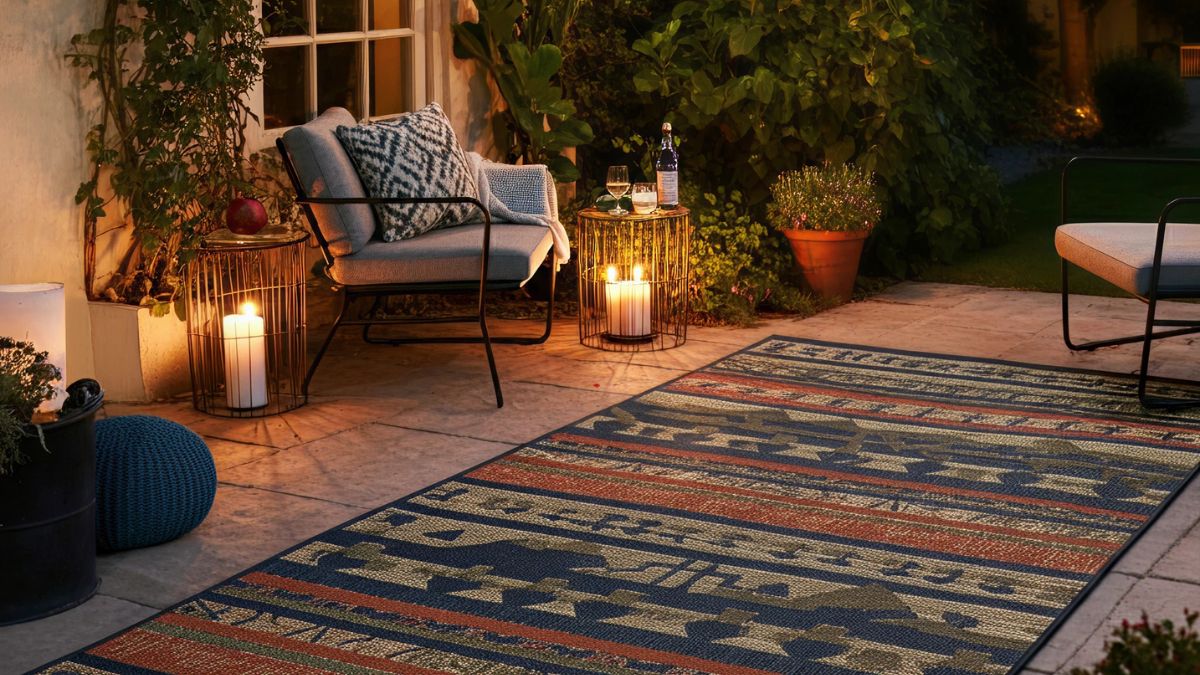Your outdoor space deserves the same attention to comfort and style as your living room. While many homeowners focus on furniture and lighting for their patios, decks, and gardens, one element often gets overlooked: flooring. Outdoor carpets offer an affordable, versatile solution that can instantly transform any exterior space from bland to beautiful.
Whether you’re looking to define seating areas, add warmth underfoot, or simply inject some personality into your outdoor living space, the right carpet can make all the difference. This comprehensive guide will walk you through everything you need to know about choosing, installing, and maintaining outdoor carpets to create the perfect outdoor oasis.
What Makes Outdoor Carpets Different?
Outdoor carpets are specifically engineered to withstand the elements that would quickly destroy indoor flooring. Unlike their interior counterparts, these hardy textiles are built to handle rain, sun, temperature fluctuations, and heavy foot traffic without losing their appearance or structural integrity.
The key lies in their construction and materials. Most outdoor carpets feature synthetic fibers like polypropylene, polyester, or recycled plastic that resist moisture absorption. These materials won’t harbor mold or mildew, even when exposed to humidity and occasional soaking. Additionally, they’re typically treated with UV-resistant coatings to prevent fading from constant sun exposure.
The backing of outdoor carpets is equally important. Marine-grade backings allow water to drain through rather than pooling on top, while specialized adhesives and stitching techniques ensure the carpet maintains its shape through countless wet-dry cycles.
Types of Outdoor Carpets for Every Space
Flat-Weave Outdoor Rugs
Flat-weave designs represent the most popular category of outdoor carpets. These thin, tightly woven options offer excellent durability and are typically the most budget-friendly choice. The low profile makes them easy to clean—simply hose them down and let them air dry.
Flat-weave rugs work particularly well on covered patios and under outdoor furniture. Their streamlined construction means they won’t trap dirt and debris like thicker options might.
Braided Outdoor Carpets
For a more traditional, homey aesthetic, braided outdoor carpets bring warmth and texture to exterior spaces. These are created by weaving multiple strands together in rope-like patterns, resulting in a durable surface that can handle heavy use.
Braided styles are especially suited to country, coastal, and farmhouse-inspired outdoor décor. They’re available in both solid colors and multi-colored options that can help hide minor stains and wear.
Synthetic Grass Carpets
Synthetic grass offers the lush appearance of a lawn without the maintenance requirements. Modern artificial turf has come a long way from the obviously fake options of decades past. High-quality synthetic grass carpets now feature varying blade heights, natural color variations, and realistic textures.
These work exceptionally well for rooftop terraces, balconies, and areas where natural grass won’t grow. They’re also ideal for homes with pets, as they’re easy to clean and won’t develop bare patches from heavy use.
Interlocking Carpet Tiles
For maximum flexibility, interlocking outdoor carpet tiles allow you to create custom patterns and easily replace damaged sections. These modular options snap together to form larger carpeted areas, making installation straightforward even for beginners.
Carpet tiles are perfect for irregularly shaped spaces or areas where you might want to change the layout seasonally. They’re also excellent for renters who want to improve their outdoor space without permanent modifications.
Choosing the Right Size and Style
Measuring Your Space
Before shopping for outdoor carpets, take accurate measurements of your intended area. For dining spaces, ensure the carpet extends at least 24 inches beyond the table on all sides so chairs remain on the rug even when pulled out. In seating areas, the front legs of sofas and chairs should rest on the carpet for the most cohesive look.
Consider traffic patterns when determining size. High-traffic walkways benefit from wider carpets that won’t create trip hazards, while intimate conversation areas can use smaller accent rugs to define the space.
Color and Pattern Considerations
Outdoor carpets face unique color challenges due to sun exposure and dirt accumulation. Darker colors show dust and pet hair more readily but hide stains better. Lighter shades reflect heat and create an airy feeling but may require more frequent cleaning.
Patterned carpets offer the best of both worlds—they can camouflage minor stains while adding visual interest to neutral outdoor furniture. Geometric patterns complement modern design schemes, while florals and botanicals enhance garden-inspired spaces.
Remember that outdoor carpets will likely fade over time, regardless of UV protection. Choose colors you’ll still enjoy when they’re a few shades lighter than their original appearance.
Installation and Placement Tips
Preparing the Surface
Proper surface preparation ensures your outdoor carpet stays put and lasts longer. Clean the area thoroughly, removing debris, leaves, and any standing water. For concrete patios, check for cracks or uneven areas that might cause premature wear.
Wooden decks should be inspected for protruding nails or screws that could snag the carpet backing. Sand down any rough spots and ensure the deck surface is completely dry before installation.
Securing Your Carpet
Most outdoor carpets don’t require permanent installation, but windy conditions may necessitate additional securing methods. Outdoor carpet tape works well for flat surfaces, while weighted corners or decorative outdoor furniture can keep rugs in place naturally.
For semi-permanent installations, outdoor carpet adhesive provides a stronger hold while still allowing for seasonal removal. Apply adhesive sparingly to avoid creating a permanent bond that would damage the underlying surface.
Weather Protection Strategies
Even weather-resistant outdoor carpets benefit from some protection during extreme conditions. Consider rolling up or storing carpets during severe storms, extended periods of rain, or when you’ll be away for extended periods.
Position carpets to take advantage of natural drainage patterns, avoiding areas where water typically pools. Slight slopes that encourage water runoff will help prevent moisture-related issues.
Maintenance and Care
Regular Cleaning Routine
Outdoor carpets require more frequent maintenance than indoor options due to their exposure to the elements. Weekly sweeping or vacuuming removes surface dirt before it becomes embedded in the fibers. Pay special attention to high-traffic areas and spots where outdoor furniture creates friction.
Monthly deep cleaning with a garden hose removes accumulated grime and prevents the buildup that can lead to permanent discoloration. Allow carpets to dry completely before replacing furniture to prevent mold and mildew growth.
Dealing with Stains
Address spills immediately to prevent staining. Most outdoor carpet materials respond well to simple soap and water solutions. For tougher stains, enzyme-based cleaners designed for outdoor use can break down organic matter without damaging synthetic fibers.
Avoid bleach-based products, which can weaken carpet fibers and cause uneven fading. When in doubt, test cleaning products in an inconspicuous area first.
Seasonal Storage
While many outdoor carpets can remain outside year-round, seasonal storage extends their lifespan significantly. Clean carpets thoroughly before storage, ensuring they’re completely dry to prevent mold growth during storage months.
Roll rather than fold carpets to prevent permanent creases. Store in a dry, ventilated area away from rodents and insects that might find the synthetic materials appealing for nesting.
Budget-Friendly Options vs. Premium Choices
Understanding Price Differences
Outdoor carpet prices vary widely based on materials, construction quality, and brand reputation. Budget options, typically priced under $100 for standard sizes, offer basic weather resistance and simple patterns. These work well for seasonal use or areas with light traffic.
Mid-range carpets, usually between $100-300, feature better UV protection, more sophisticated patterns, and improved durability. These represent the sweet spot for most homeowners, offering good longevity without breaking the budget.
Premium outdoor carpets, often exceeding $300, incorporate advanced materials, superior construction techniques, and designer aesthetics. These justify their higher cost through exceptional durability and fade resistance that can last for many seasons.
Where to Save and Where to Splurge
Save money on outdoor carpets for low-traffic areas, covered spaces with minimal weather exposure, and seasonal decorating. Basic flat-weave options work perfectly well in these situations.
Invest in higher-quality carpets for high-traffic entertaining areas, spaces with direct sun exposure, and areas where the carpet will remain year-round. The improved durability of premium options makes them more economical over time in demanding conditions.
Eco-Friendly Outdoor Carpet Options
Recycled Materials
Many manufacturers now produce outdoor carpets from recycled plastic bottles and other post-consumer materials. These eco-friendly options offer the same durability as traditional synthetic carpets while reducing environmental impact.
Recycled plastic outdoor carpets are often surprisingly soft underfoot while maintaining excellent weather resistance. They’re available in numerous colors and patterns, proving that environmental responsibility doesn’t require sacrificing style.
Natural Fiber Alternatives
While fully natural fibers struggle with moisture resistance, some outdoor carpets blend natural materials with synthetic components for improved sustainability. Jute-backed carpets with synthetic pile offer a compromise between environmental consciousness and weather resistance.
These hybrid options work best in covered outdoor areas with minimal moisture exposure. They provide the organic aesthetic many homeowners prefer while offering better longevity than purely natural alternatives.
Transform Your Outdoor Living Experience
Outdoor carpets represent one of the most cost-effective ways to upgrade your exterior living spaces. They provide comfort, define areas, and inject personality into patios, decks, and gardens that might otherwise feel cold or uninviting.
The key to success lies in matching your carpet choice to your specific needs, climate, and usage patterns. Consider your local weather conditions, maintenance preferences, and design aesthetic when making your selection. With proper care and thoughtful placement, a quality outdoor carpet can provide years of enhanced outdoor living enjoyment.
Start by measuring your space and identifying your primary needs—whether that’s durability, style, or budget-consciousness. Visit local home improvement stores to feel different materials and see colors in person, as online photos can be misleading for outdoor applications.
Remember that outdoor carpets are an investment in your home’s livability and value. Choose wisely, maintain regularly, and enjoy the transformation they bring to your favorite outdoor spaces.










